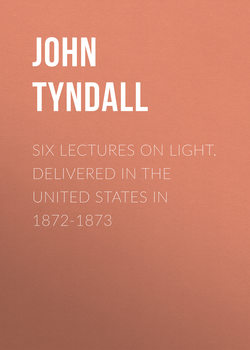Читать книгу Six Lectures on Light. Delivered In The United States In 1872-1873 - John Tyndall - Страница 8
LECTURE I
§ 6. Descartes' Explanation of the Rainbow
ОглавлениеSnell's law of refraction is one of the corner-stones of optical science, and its applications to-day are million-fold. Immediately after its discovery Descartes applied it to the explanation of the rainbow. A beam of solar light falling obliquely upon a rain-drop is refracted on entering the drop. It is in part reflected at the back of the drop, and on emerging it is again refracted. By these two refractions, and this single reflection, the light is sent to the eye of an observer facing the drop, and with his back to the sun.
Conceive a line drawn from the sun, through the back of his head, to the observer's eye and prolonged beyond it. Conceive a second line drawn from the shower to the eye, and enclosing an angle of 42½° with the line drawn from the sun. Along this second line a rain-drop when struck by a sunbeam will send red light to the eye. Every other drop similarly situated, that is, every drop at an angular distance of 42½° from the line through the sun and eye, will do the same. A circular band of red light is thus formed, which may be regarded as the boundary of the base of a cone, with its apex at the observer's eye. Because of the magnitude of the sun, the angular width of this red band will be half a degree.
From the eye of the observer conceive another line to be drawn, enclosing an angle, not of 42½°, but of 40½°, with the prolongation of the line drawn from the sun. Along this other line a rain-drop, at its remote end, when struck by a solar beam, will send violet light to the eye. All drops at the same angular distance will do the same, and we shall therefore obtain a band of violet light of the same width as the red band. These two bands constitute the limiting colours of the rainbow, and between them the bands corresponding to the other colours lie.
Thus the line drawn from the eye to the middle of the bow, and the line drawn through the eye to the sun, always enclose an angle of about 41°. To account for this was the great difficulty, which remained unsolved up to the time of Descartes.
Taking a pen in hand, and calculating by means of Snell's law the track of every ray through a raindrop, Descartes found that, at one particular angle, the rays, reflected at its back, emerged from the drop almost parallel to each other. They were thus enabled to preserve their intensity through long atmospheric distances. At all other angles the rays quitted the drop divergent, and through this divergence became so enfeebled as to be practically lost to the eye. The angle of parallelism here referred to was that of forty-one degrees, which observation had proved to be invariably associated with the rainbow.
From what has been said, it is clear that two observers standing beside each other, or one above the other, nay, that even the two eyes of the same observer, do not see exactly the same bow. The position of the base of the cone changes with that of its apex. And here we have no difficulty in answering a question often asked—namely, whether a rainbow is ever seen reflected in water. Seeing two bows, the one in the heavens, the other in the water, you might be disposed to infer that the one bears the same relation to the other that a tree upon the water's edge bears to its reflected image. The rays, however, which reach an observer's eye after reflection from the water, and which form a bow in the water, would, were their course from the shower uninterrupted, converge to a point vertically under the observer, and as far below the level of the water as his eye is above it. But under no circumstances could an eye above the water-level and one below it see the same bow—in other words, the self-same drops of rain cannot form the reflected bow and the bow seen directly in the heavens. The reflected bow, therefore, is not, in the usual optical sense of the term, the image of the bow seen in the sky.
